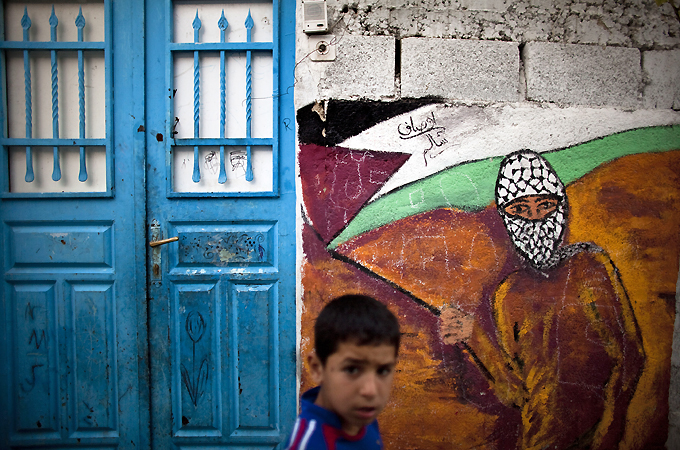The struggle for East Jerusalem
Palestinian communities in East Jerusalem are waging a campaign of popular resistance against Israeli land confiscation.

 |
| Israel continues to expand Jewish settlements in East Jerusalem, placing an increased strain on Palestinian communities in the city [Getty] |
Half way down a hill, sandwiched between Jerusalem’s Hadassa hospital and Hebrew University, sits the compact and overcrowded occupied East Jerusalem village of Issawiya.
Before crossing the makeshift police checkpoint of concrete block obstacles at the edge of the University and entering the neighbourhood – which resembles more of a besieged West Bank refugee camp than a Jerusalem municipality – there is a clearly marked ‘Dead End’ street sign. On the main road leaving towards the hospital on the other side of the neighbourhood there is a wall of concrete cubes blocking any traffic, leaving just a narrow space for pedestrians to cross.
Although the Jewish dominated Hebrew University has expanded onto Issawiya’s land, the picture of Jerusalem from both places couldn’t be more different. While Israeli students attend classes oblivious to life beyond the ‘dead end’, Israeli security forces have orchestrated a campaign of regular night time arrest raids against Issawiya residents in an effort to halt growing popular resistance to segregation, home demolition and land confiscation.
The recent Israeli home demolitions, increasing the pressure on the already squeezed Palestinian community, have given rise to local youth organising ruckus street demonstrations, clashing with Israeli police and border guards at the neighbourhood checkpoints. Now the campaign has expanded and the youth of Issawiya have been joined by Israeli anti-occupation activists.
With Israel continuing to expand Jewish settlements in East Jerusalem, squeezing and displacing the Palestinian residents under the banner of an undivided Israeli capital (a claim rejected by most of the world), the Palestinian Authority has been powerless in defending the residents of their future capital. Meanwhile, despite murmurs of discontent from Washington and the international community, international diplomacy has proven just as ineffective in advocating for the rights of Jerusalem’s Palestinian residents.
Now, failed by national leadership and abandoned by an international community to the mercy of an Israeli government that is forcing them from sight in order to make way for Israeli control and settlement, Palestinian residents are taking it on themselves to defend their land, rights and presence.
As a result, East Jerusalem Palestinians are seeking to use local resistance to gain a voice in a city where decisions are governed by Israeli national and international interests. Issawiya has become the latest East Jerusalem community to instigate protests inspired by the village of Bi’lin’s model of popular demonstrations coupled with international appeals for civil society and legal action. Loosing a vast amount of village lands to Israel’s wall and settlements in 2005, the West Bank border village pioneered the modern Palestinian model for using popular resistance to fight land annexation. None-th-less, the leader of Bi’lin’s popular committee, Abdullah Abu Rahmah, remains in Israeli military prison after completing an internationally condemned one year military court sentence for his political organising.
At Issawiya’s first joint Palestinian-Israeli demonstration on December 3, hundreds of local residents joined by left-wing Israelis chanted “From Issawiya to Bil’in, we are all Palestine” in Arabic.
“There are many checkpoints, the Israelis close many of our roads and we can’t get out of our village,” said Issawiya resident Rania Arafat who also discussed her brother’s arrest in the recent night raids. “They have taken more than 800 dunnams of our land. We need that land to build houses, we need to be able to live in our village,” she added.
The unrest in Issawiya has built on the momentum of local campaigns against Israeli settler evictions and home occupations in the East Jerusalem neighbourhood of Sheikh Jarrah and more recent unrest against increasing settler presence and Palestinian home demolition in the Silwan neighbourhood. “We are from the same city and are in the same situation. This is what’s happening in Jerusalem,” contends Arafat.
Responding to Palestinian families evicted from their homes by Israeli settlers, last year Sheikh Jarrah was the first Jerusalem community to mount a popular struggle campaign following Bil’in’s example. Yet, despite a broad non-violent protest movement that has brought participation from liberal Israelis, the settlers remain a year on. Not surprisingly, having seen peaceful means yet to remove the settlers, the struggle in Silwan has primarily opted for clashes and rioting to pressure the Israeli government, while Issawiya residents have adopted a mixed approach of joint non-violent struggle with Israelis and local youth clashing with police.
The emergence of these sustaining and expanding local popular struggles is a potential game changer for Palestinians to respond to the increasing segregation and marginalisation in Jerusalem. As Israel has traditionally tried to hamper Palestinian organising in Jerusalem through barring the activity of the PLO and Palestinian national movements, those national grievances are now finding local expression.
While clashes in Jerusalem have traditionally been sparked by emotional responses to Israeli symbolic provocations at sites like the the Al-Aqsa Mosque, now they are part of a calculated escalation that’s building neighbourhood by neighbourhood in response an Israeli policy of systematic discrimination.
No doubt this is a new form of struggle for the residents of occupied East Jerusalem, one that relies on sustained local resistance to challenge the Israeli policy of Jewish dominance carried out for National interests and negotiated on the international stage.
For years now the popular unarmed resistance has been spreading across West Bank villages along the rout of Israel’s wall, but the recent emergence of this type of campaign in easily ignitable Jerusalem could force a local Palestinian voice onto a political playing field that has treated Jerusalem Palestinians as an oppressed object rather than an agent for change.
Jesse Rosenfeld is a freelance journalist based in Ramallah and Tel Aviv. He is an editor of www.thedailynuisance.com.